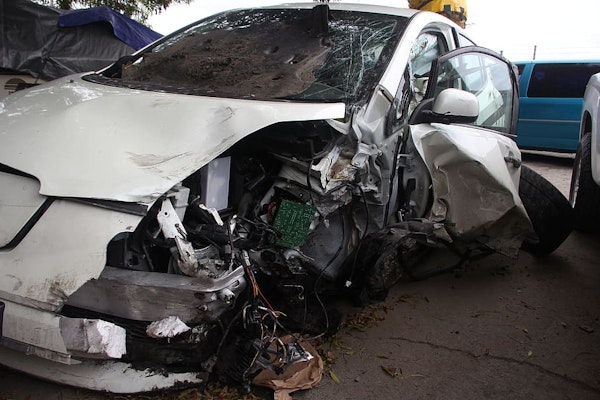
Misunderstood: Partially Automated Vehicles Are Not Self-driving
Drivers who use partial automation on a regular basis often treat their vehicles as fully self-driving despite widespread warnings and numerous high-profile crash reports, a new study from the Insurance Institute for Highway Safety shows.
October 11, 2022
Auto
Technology

In Search of Standards for Totaled Auto Claims Software
Basit Mian sued Progressive County Mutual Insurance, J.D. Power & Company, and Mitchell International Company, Inc., in a Texas Federal District Court, charging that Progressive’s use of a computer program called Work Center Total Loss (WCTL) undervalued his totaled vehicle by $2,073.24.
October 4, 2022
Auto
Technology

The Cloud: Connecting the Insurance Ecosystem
Cloud-based platforms will let auto insurers make a critical pivot away from purely reactive claims response and processing to claims minimization and avoidance.
September 30, 2022
Insurance Industry
Technology

Hackers Testing Data Destruction to Make Ransomware Attacks More Effective
Ransomware hackers are experimenting with a new kind of attack that, instead of encrypting data, outright destroys it. The aim is to make it impossible for victims to retrieve their data if they don’t pay the ransom.
September 28, 2022
Excess & Surplus Lines
Fraud
Technology

How AI Is Changing The Game In Insurance
The insurance industry is one of the largest in the world and has been around for hundreds of years, making it ripe for transformation by newcomers in the space. Over the past five to ten years, technology has pushed the frontier of what’s possible, making way for a new breed of digital-first insurance companies to come to life.
September 28, 2022
Insurance Industry
Technology

The Doctor Is In Your Device
Star Trek was ahead of its time in many ways, and not just because the sci-fi franchise portrayed a future several centuries after the series first aired in the 1960s. The cult classic TV show/films imagined what life might be like in the 23rd century, when humankind could be hurtling on spaceships through unknown universes. Much of the show was fantasy, of course, but the series has been heralded for foreshadowing the future.
September 27, 2022
Life & Health
Technology

The Insurance of Insurers
What is the impact of artificial intelligence in insurance? Well, there are a lot of use cases for artificial intelligence in everyday life, but what about AI in insurance? The effects of artificial intelligence in business heavily include insurance.
September 23, 2022
Technology
Underwriting

What Adjusters Need To Know at the Peak of Hurricane Season
Recently, I hosted a training for inside adjusters, and the group consisted of around 20 seasoned claims professionals with an average tenure exceeding seven years. Most of these inside adjusters had spent at least a couple of years in the field, as well.
September 22, 2022
Education & Training
Technology

The Internet Of The Sky: Space, Remote Sensing, ESG, And Cybersecurity
Sustainability is driving the confluence of the environmental, social, and governance (ESG) pillar landscape; cybersecurity; and satellite remote sensing data. Business moves faster than weather data flows, and delays in accessing current data create a broken value chain.
September 19, 2022
Technology

The Use of Apps to Stage Car Accidents
Insurance fraud is anything but a new concern for insurance companies and counsel. A simple online search reveals a litany of articles, investigations and reports of scams and schemes developed by would-be plaintiffs to secure damages based on accidents that were not accidental and injuries that were never sustained.
September 16, 2022
Fraud
Technology

Adjusters Should Be On the Front Line of Innovation
For the preoccupied adjuster flooded with claim assignments, there has been a mystery associated with the industry term ‘insurtech.’ And if that describes you, this combination of words revolves around technological innovations aimed at improving the efficiency of the insurance world.
September 15, 2022
Insurance Industry
Technology

Security Company Partners With State Farm to Boost Homeowners’ Risk Mitigation
State Farm recently announced that it has invested $1.2 billion into the ADT Inc security company, for approximately 15 percent equity and a move to support new home insurance advancements. The partnership between the two companies allows the insurer to imagine new forms of coverage.
September 9, 2022
Property
Risk Management
Technology

The Soaring Cost of Insurance Fraud
While we all know that insurance fraud is a massive problem, we now know just how massive: more than $300 billion-a-year massive, just in the U.S. That figure comes from the Coalition Against Insurance Fraud, whose estimate would mean that fraud costs each person in the U.S. some $930 a year and the average family some $3,750.
August 30, 2022
Auto
Fraud
Life & Health
Property
Technology

Augmented Reality Invaluable To Insurers In Post-Pandemic World
According to leading data and analytics company GlobalData, augmented reality (AR) is set to become a $152 billion market by 2030, and its use cases for the insurance sector are only growing. The company notes that the technology’s demand among insurers has been catalysed by COVID-19 and the need for remote inspections.
August 24, 2022
Insurance Industry
Technology

A ’Nightmare Scenario’: Data-Tampering Attacks Are Hard To Detect, With Devastating Consequences
Imagine a cybersecurity catastrophe like this one: A pharmaceuticals maker suffers a data breach, but no data is stolen and no ransomware is deployed. Instead the attacker simply makes a change to some of the data in a clinical trial -- ultimately leading the company to release the wrong drug.
August 24, 2022
Fraud
Technology





